This is not my first encounter with a Ford Mustang Shelby GT500. I was once fortunate enough to lay hands on a spanking new 2013 Shelby GT500 for the express purpose of unleashing it on a cross-country road trip from Atlanta to Los Angeles. That car was a 662-horsepower blunt instrument that was made all the more beastly by a balky six-speed manual gearbox that could complete a 0-to-60 mph speed run in first gear.
But the powertrain was not the most knuckle-dragging aspect of that car. No, that would be the solid-axle rear suspension, which only reminded me how much I resented the Mustang for its stubborn reliance on such truckish underpinnings. Oh sure, the 1999-2004 SVT Cobra had independent rear suspension, but that was a low-volume special with a clumsy IRS adaptation. It hardly counts.
My opinion utterly changed when the Mustang underwent its sixth-generation redesign. The 2015 Ford Mustang came standard with a well-conceived IRS system that was equally impressive on autocross courses and high-speed circuits alike. Now, finally, this latest generation gains its own GT500, complete with IRS, plus 760 horsepower, a seven-speed DCT and an optional Carbon Fiber Track Pack suspension and tire upgrade. I cannot wait to have a look.
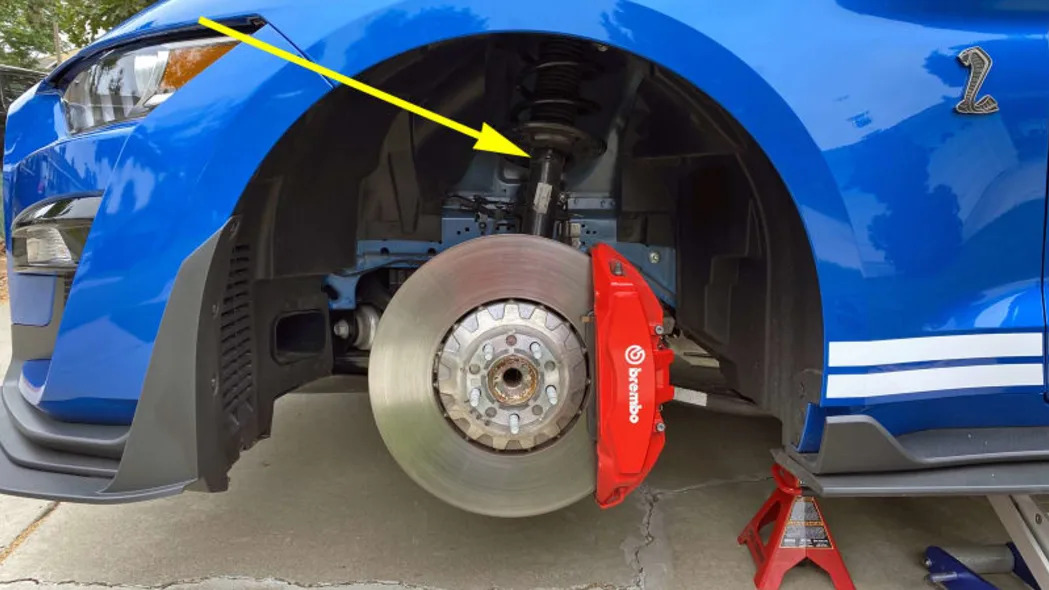
This initial view of the GT500’s front suspension is largely hidden behind a massive set of brakes, but a strut suspension (yellow) is still discernible over the top.
At just over 16.5 inches in diameter, these pizza-sized front rotors are a full inch bigger than those found on a GT350. These are composite rotors made by German supplier SHW, so named because the 40mm-thick cast-iron friction ring is connected to the central aluminum hub via a series of stainless steel pins. This construction allows the rotor to float somewhat to curb vibration, but the aluminum center section also trims unsprung weight. That’s going to be a theme with this car.
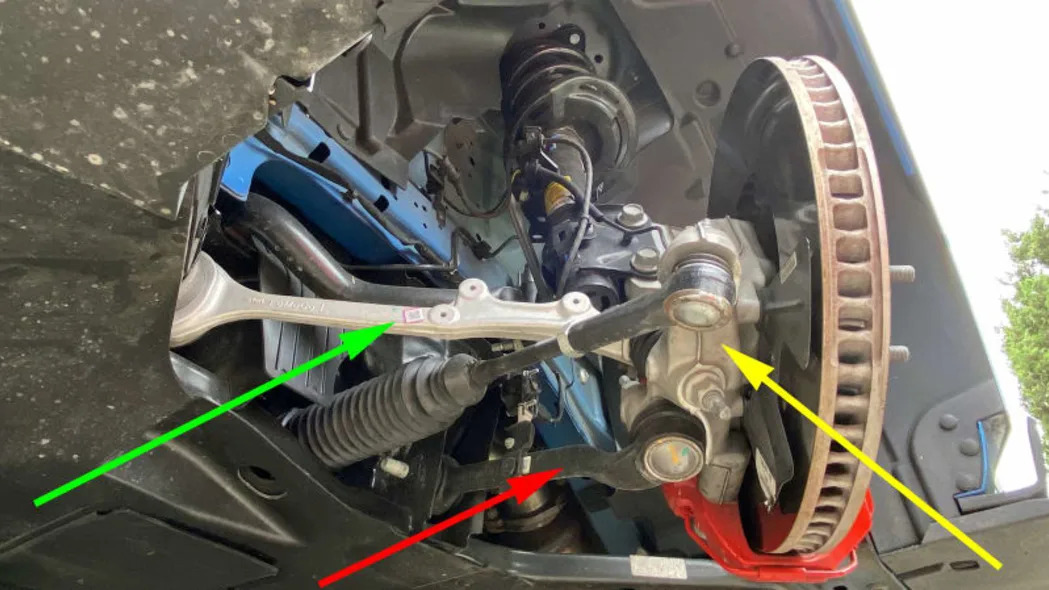
All sixth-generation Mustangs have a dual-pivot lower linkage instead of a single lower control arm, but I saw nothing but cast iron and steel the last time I crawled under a 2015 Mustang GT. Here it’s plain to see that the GT500’s knuckle (yellow) and the forward link (green) have switched to aluminum. As for the lateral link (red), it’s still made of steel.
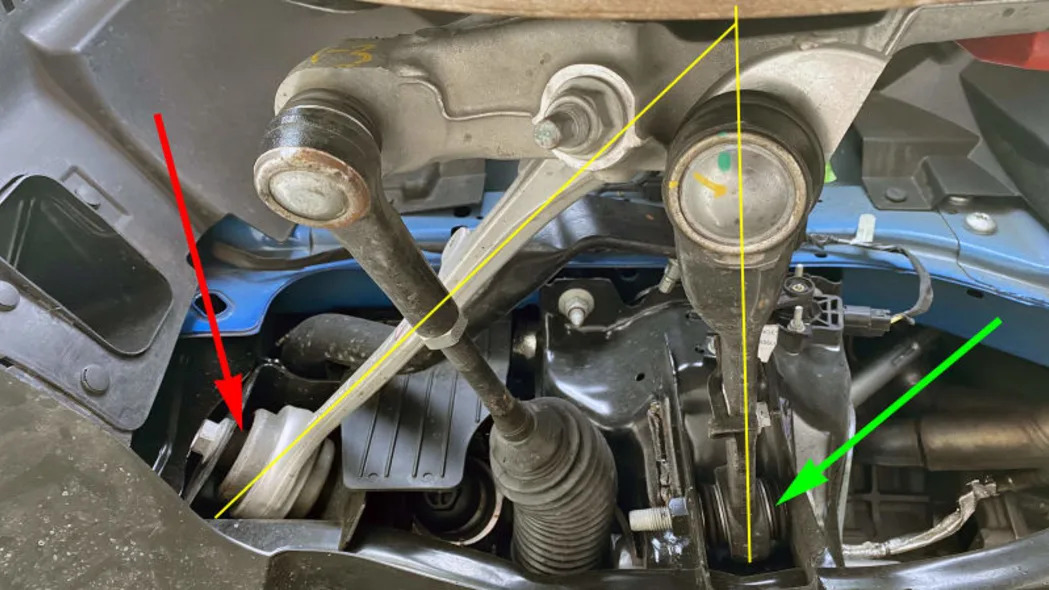
The steel lateral link takes up the lion’s share of the cornering loads. These will be immense in a performance-focused car like the GT500, so this link’s inner pivot (green) employs a ball joint for maximum lateral stiffness. But the world isn’t smooth, so the angled aluminum tension link has a high volume rubber bushing (red) at its inner connection point. Pothole strikes and other big hits will tend to shove the hub rearward, and this bushing is there to take the edge off.
But the central idea behind a dual ball joint arrangement is to move the lower steering pivot point outward to a spot that would otherwise be physically impossible with a wishbone and a single ball joint. The steering pivot point here is a virtual one that resides at the intersection of lines drawn through the center of each link’s bushings. If you project that point down to the tire’s contact patch you’ll get a small scrub radius that enhances steering precision and direct feel.
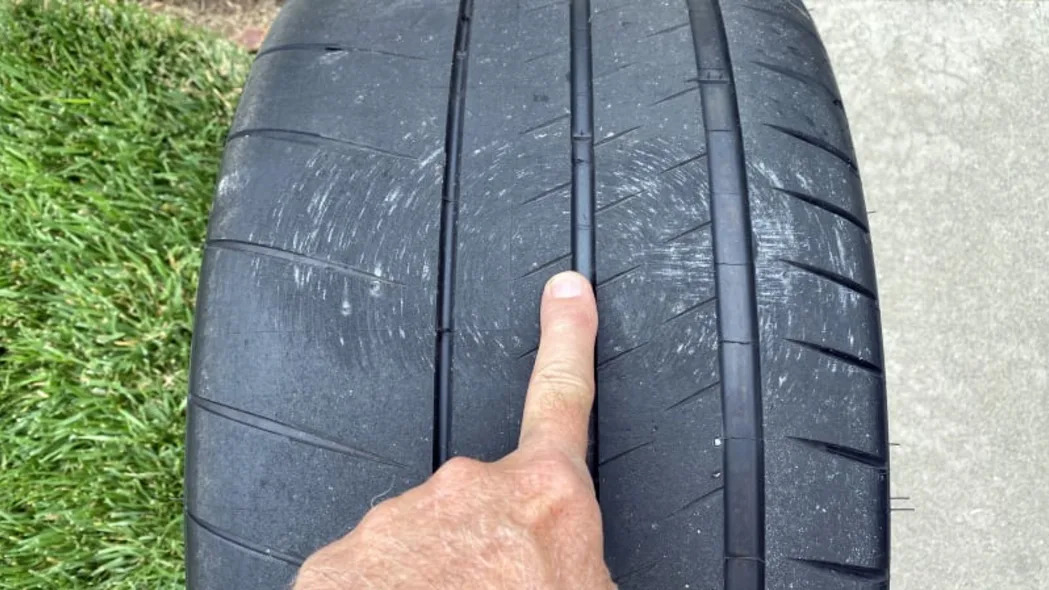
I scrubbed the steering back and forth before I got started, and these marks are the result. They converge at a point that is slightly inboard of the midpoint of the tire’s contact patch. The scrub radius isn’t zero, but it is quite small -- which is no mean feat considering the GT500’s massive 305 mm-wide front tires. A Ford engineer reminded me that the virtual pivot point does migrate somewhat as the two links move about each other, and that makes it important to not get too greedy in your attempts to create a zero-scrub radius. You don’t want the scrub radius to switch from positive to negative as the virtual point moves about.
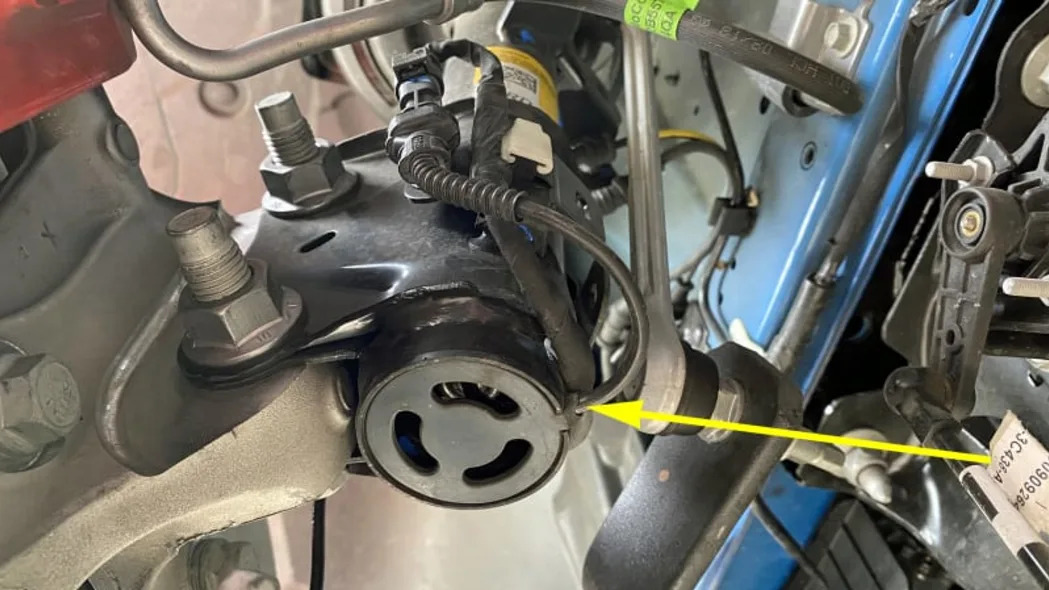
The GT500 uses magnetorheological dampers front and rear. This patented adjustable damping system appears on several high-end vehicles under the name MagneRide, and its theory of operation differs from other adjustable dampers in a fundamental way. Here the damper valving is fixed while the viscosity of the special magnetorheological damper fluid is altered. MagneRide does this by continuously adjusting an electromagnet within the damper via this input wire.
But there’s something odder still about all of this. Why is the wire coming out the bottom?
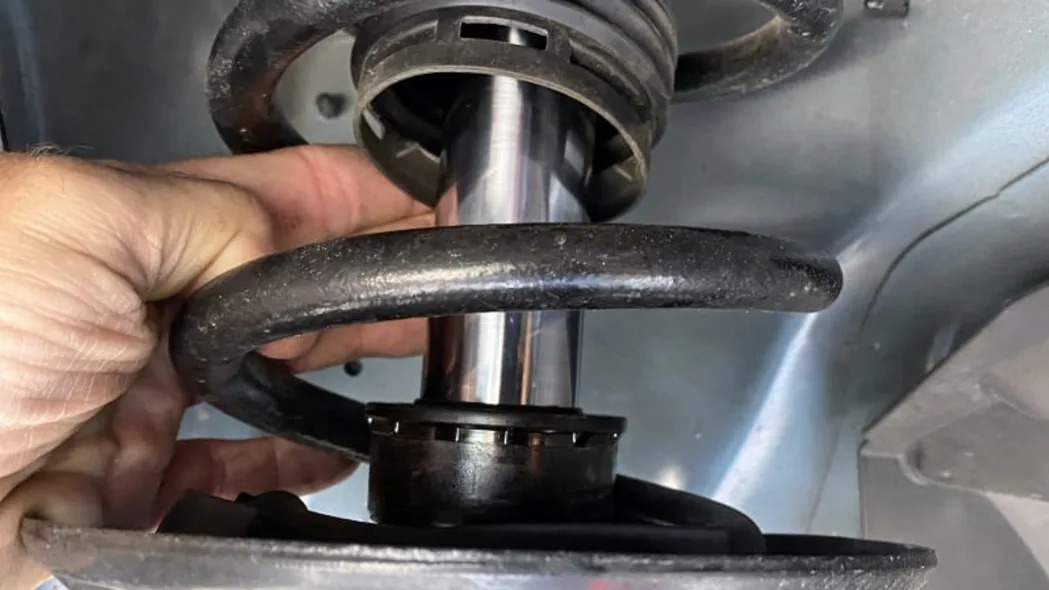
The wire comes out the bottom because the Mustang’s MagneRide front struts are inverted struts. Not following me? Think of a regular monotube shock absorber. It has to be a monotube shock so it’ll work in the inverted position. Let’s make it a Bilstein, too, because their monotube shock bodies are famous for being yellow. A MagneRide damper is most definitely not a Bilstein, but stay with me.
Turn your shock upside down so the yellow body is on top instead of down below. Drop your upside-down shock shaft-first into the strut housing and connect the shaft to the bottom. Because this is an electronically-controlled damper, the control wire that runs through the shaft will exit out the bottom. The polyurethane bump stop will be hidden down toward the bottom, too.
Why do this? Inverted struts are immensely strong. You can instantly SEE how they’re able to handle heroic cornering loads. But the GT500 isn’t the only Mustang that has them. Any Mustang with the MagneRide option will use inverted struts. The GT500’s are tuned differently, but they’ll look the same up under the dust boot.
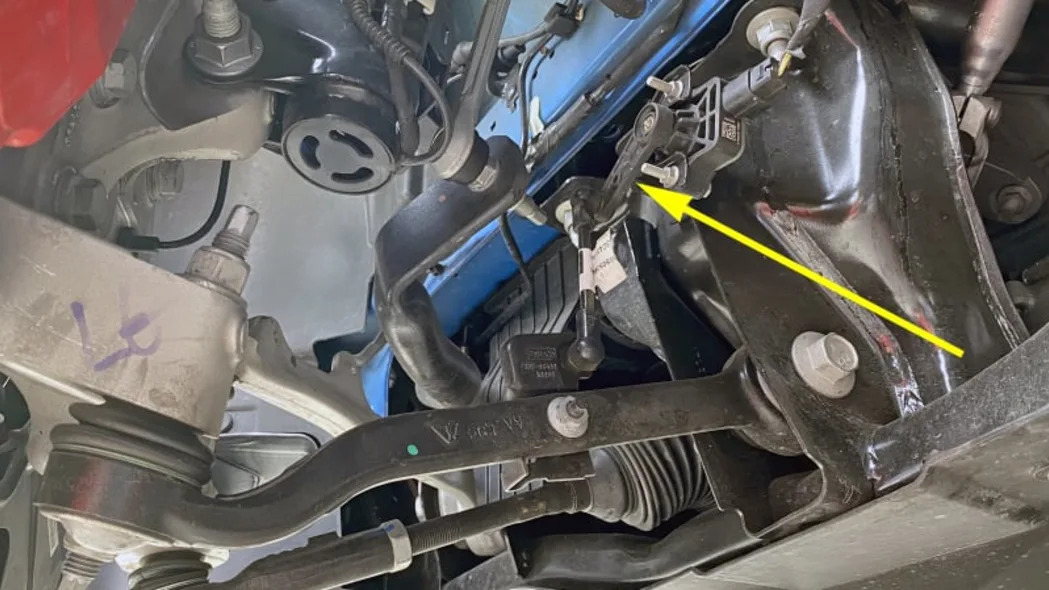
Magnetorheological dampers are continuously variable dampers, so the computer that controls them needs to monitor the position of the wheels with suspension height sensors (yellow) at all four wheels, as well as a few g sensors.
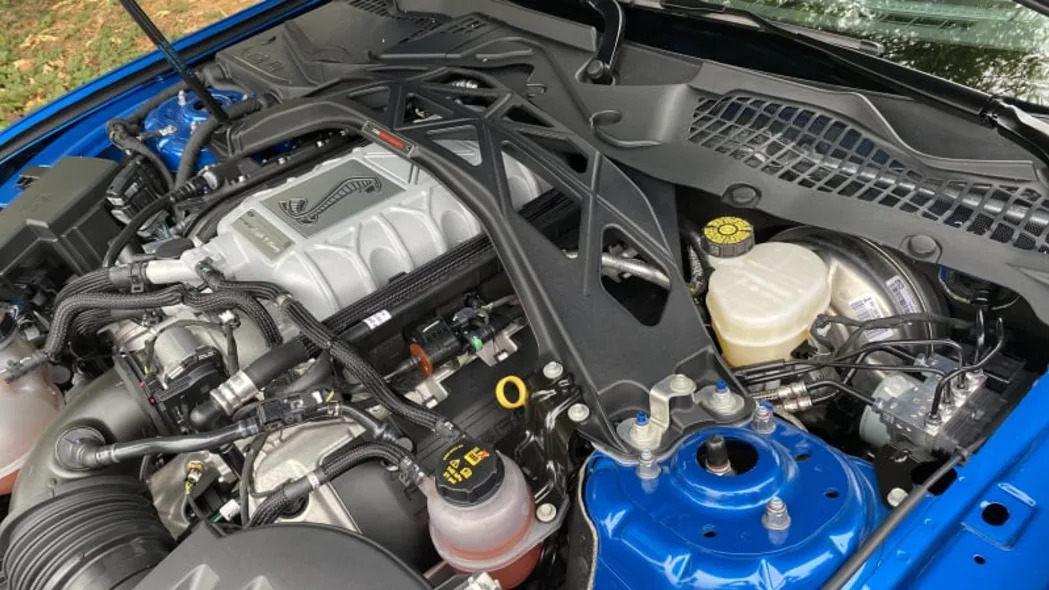
High cornering loads demand a stiff strut mounting structure, and this elaborate K-shaped strut tower brace provides that by tying both shock towers to the firewall, as well as each other.
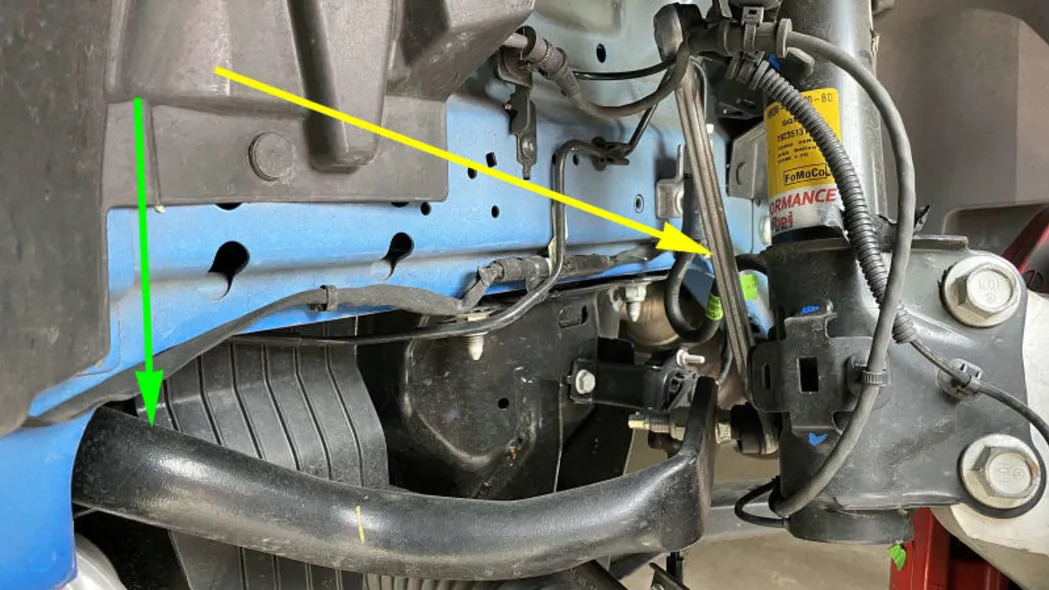
The GT500’s hollow front stabilizer bar (green) is larger than what’s fitted to any other Mustang. It has a 36 mm-diameter bar with 4.8 mm wall thickness whether you buy the Carbon Fiber Track Pack or not. The car delivers all of that, too, because its ends are connected directly to the strut housing via a drop link, a familiar setup that produces a 1-to-1 motion ratio.
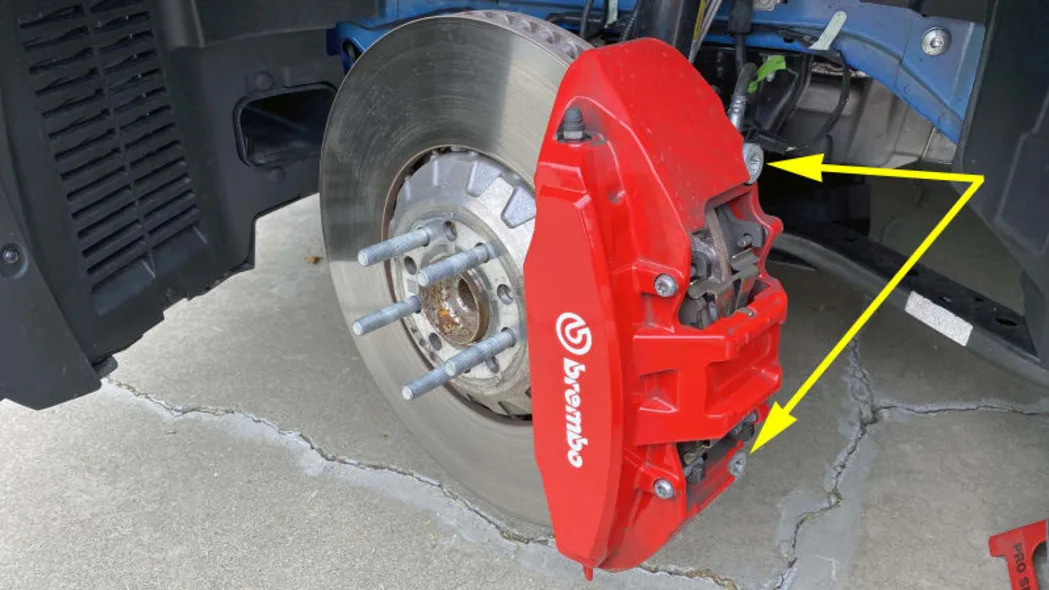
The GT500’s six-piston Brembo calipers have a fixed bridge for extra stiffness, so you’ll be removing them entirely to change brake pads. That’s done by removing these “radial mount” bolts (yellow), which is a brake engineering choice that emphasizes caliper mounting stiffness.
Apart from that, you may have noticed that the GT500’s wheel studs are uncommonly long. I wasn’t able to confirm it, but I think they’re here because the Carbon Fiber Track Pack’s carbon fiber wheels have an uncommonly thick hub center section.
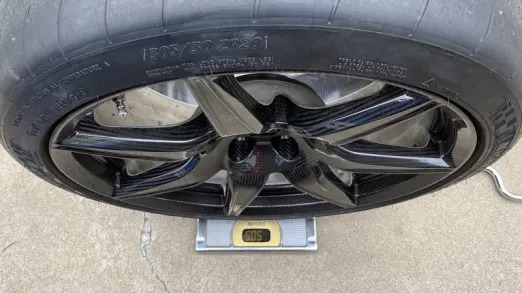

These wheels don’t weigh much at all, which represents a significant reduction in unsprung mass. That is clearly a strong point, but a Ford engineer I spoke with said that wheel stiffness is the more significant benefit. You may not realize it, but wheels can flex under high cornering loads, a scenario that reduces camber and alters the load across the tire’s contact patch. These carbon wheels are much more rigid in that regard, and that enables the GT500 to take best advantage of its very sticky (and very wide) 305 mm front tires.
These front wheels are 11-inches wide, and yet the entire assembly weighs just 50.5 pounds. How good is that? Extraordinarily good. I once measured a Mustang GT of the same generation. Its 255/45ZR19 front tires were mounted on 19-by-9 inch wheels, and that combination weighed 56.2 pounds. This GT500’s carbon front wheel assembly is nearly 6 pounds lighter DESPITE having 2 inches more tread width, one extra inch of rim diameter and 2 extra inches of rim width.
The front rim does have a coating inside, but it’s not structural in the least. It’s a deposition coating that’s been applied on top of the carbon to protect adjacent surfaces from the immense heat generated by the brakes. The material is similar to what you’d find on vulnerable spacecraft re-entry surfaces.
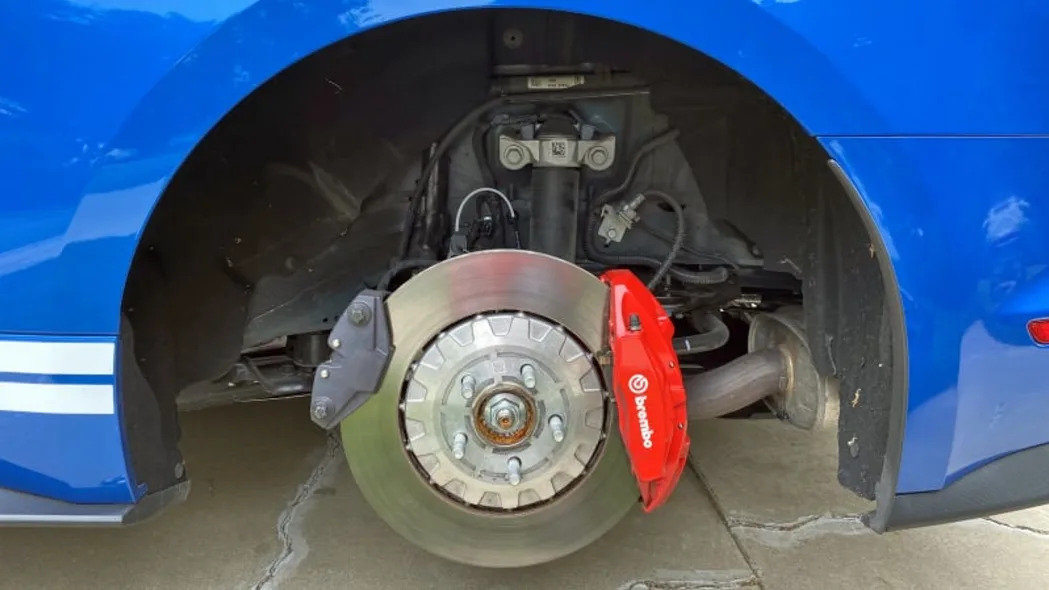
Meanwhile, at the rear, brakes once again dominate the scene and block our view. This time it’s because the tricky composite rotors are gripped by two calipers. The GT500 is the only Mustang set up this way, and it required additional changes we’ll see later on.
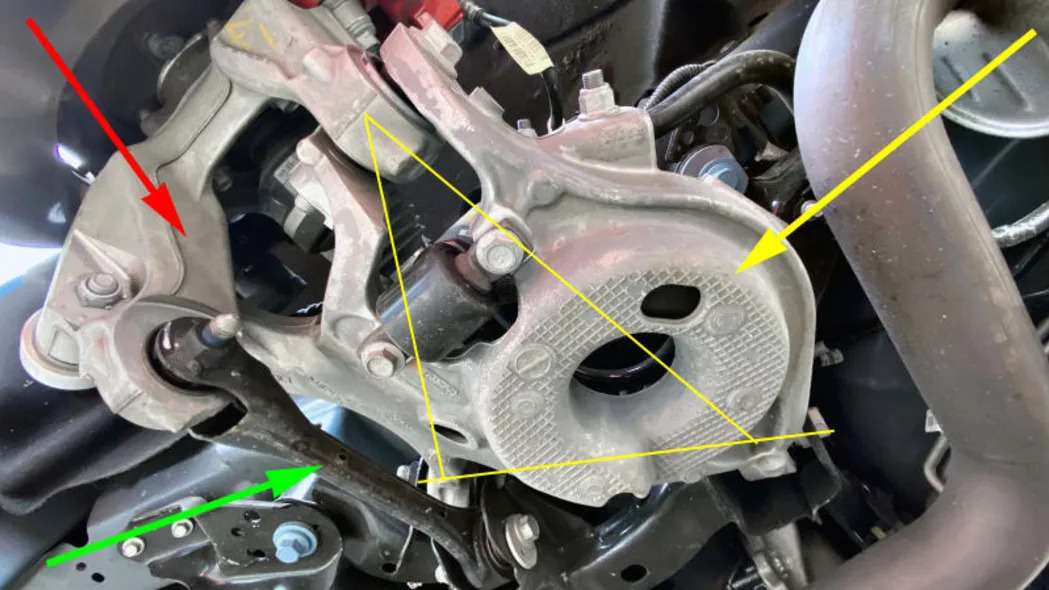
Like all sixth-generation Mustangs, the GT500 uses what’s called Integral Link rear suspension, a type of multilink suspension that is uncommonly good at enabling high lateral cornering stiffness and torque resistance while still offering a fair bit of longitudinal compliance.
The main component that draws your eye is the big lower arm (yellow) that operates like a lower wishbone. From here it looks like an A-shaped arm, but we’ll see later that it is more complicated than that. Just in front is a shorter toe link (green) that has an eccentric for toe adjustments at its inner end. Both are attached to a massive aluminum knuckle (red) that carries the rear wheel bearing and drive flange.
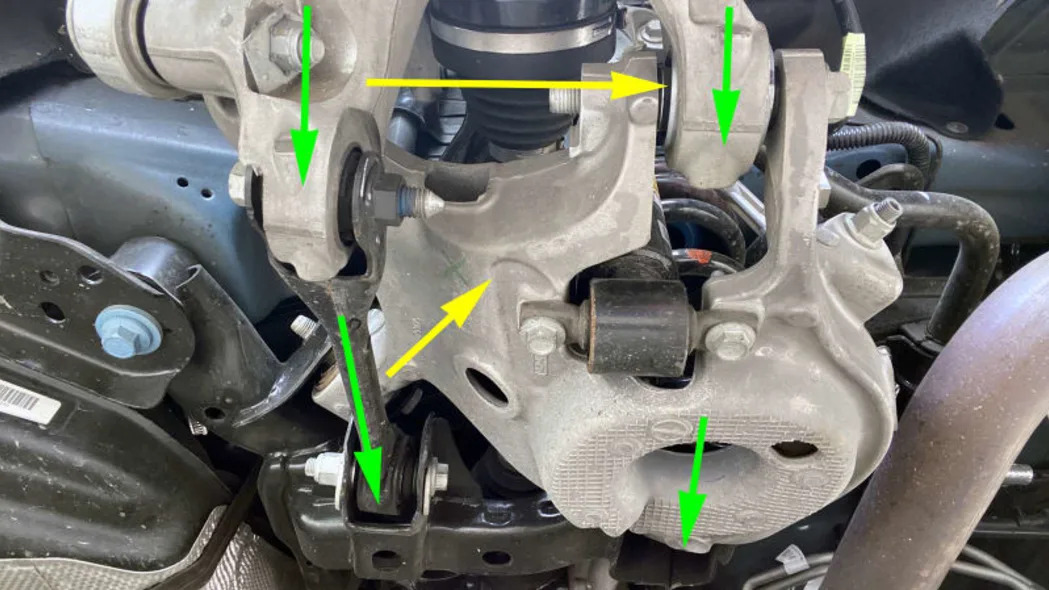
I’m attempting to show how the forces flow through these links. Green represents cornering forces, while yellow represents the longitudinal backward pulse of sharp impacts. You can see how the bushings on the green paths can be optimized for cornering, while the lower arm’s elevated inner pivot can be optimized to absorb the backward pulse as a diagonal tug across the arm.
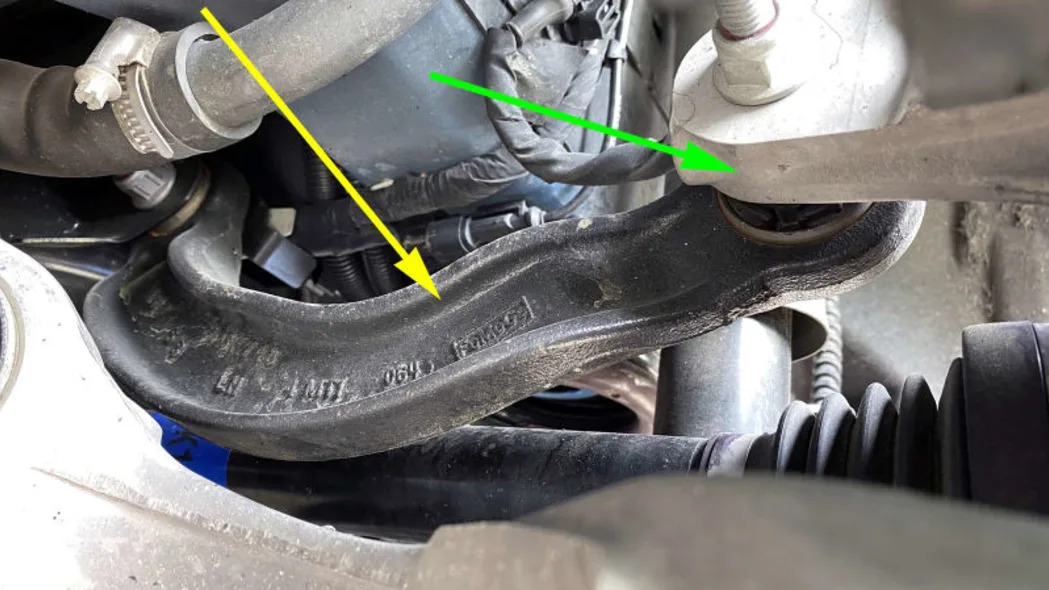
Compared to what’s going on down below, the upper link (yellow) lives a comparatively boring existence. It’s there to brace the camber angle at the upper reaches of the suspension, which isn’t a terribly difficult job because the contact patch is far enough away that it can get away with a single-shear mount (green). The dip in its shape is there to clear the body structure at full compression.
But there’s an issue. How does the upper end of the suspension resist torque loads? Wouldn’t this just flop about when you stood on the gas?

It works because our lower A-arm is in fact an H-arm. It has this extra extension (yellow) that’s there to provide a mounting point for the integral link (green) that gives this suspension type its name. And this is how this suspension takes up torque loads, it’s why the upper camber link can operate independently as a mere camber link.
Sharp-eyed sixth-gen Mustang fans may notice a bigger difference. Remember that second brake caliper we saw a few images back? Well, the knuckle had to be remade so the second brake caliper (red) had something to mount to. But that led to more changes. Mustangs without the second brake caliper have a longer integral link that extends up from the H-arm. But here the secondary brake caliper eats up that space, so the GT500 has a shorter aluminum integral link that extends down from its H-arm. The knuckle isn’t just different because it must provide caliper mounting points, it also must provide a lower integral link anchor point.
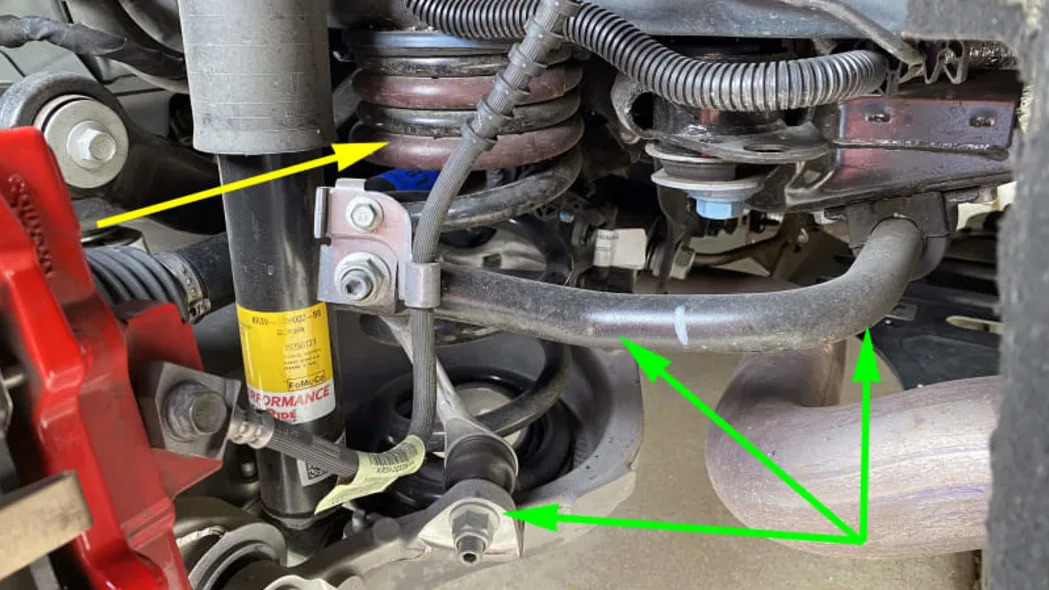
The GT500 track pack’s coil spring has very soft upper coils that are meant to go into bind (yellow) to essentially allow the car to sit lower on stiff springs while still maintaining the “normal” free length common to all Mustangs. Notably, this corner of the car is jacked up in this image and is even drooping somewhat compared to what it looks like sitting on the ground.
But it's not dropping all that much because the Track Pack version of the GT500 has a very large 1-inch hollow stabilizer bar (green) with hollow section walls that are 4.5 mm thick.
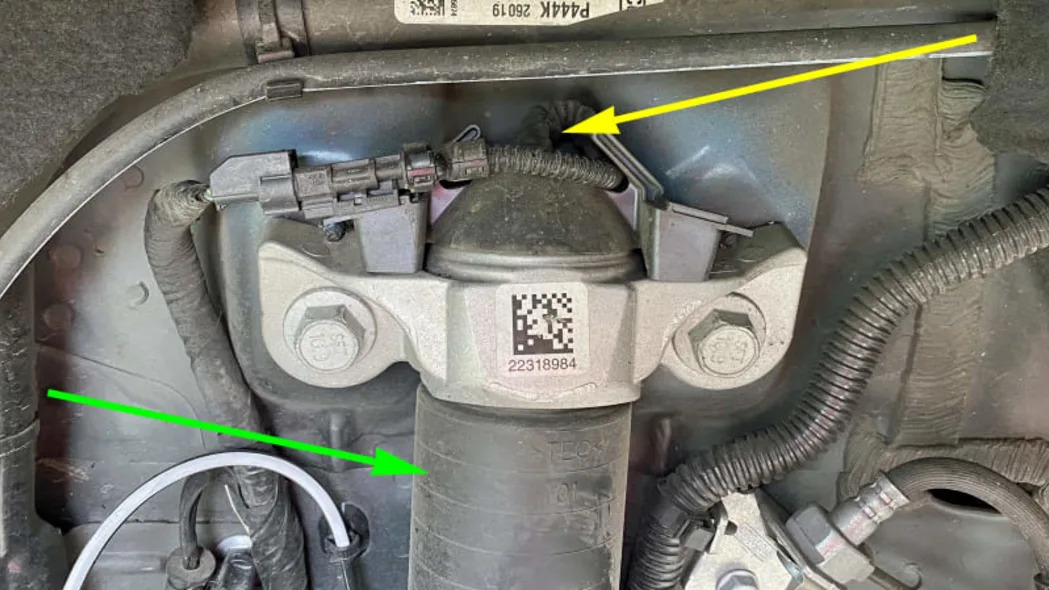
The rear end’s magnetorheological damper is not inverted, and so its voltage control wire (yellow) comes down from the top. There’s a urethane bump stop hidden behind the dust boot (green) but you’ll have to trust me on that.
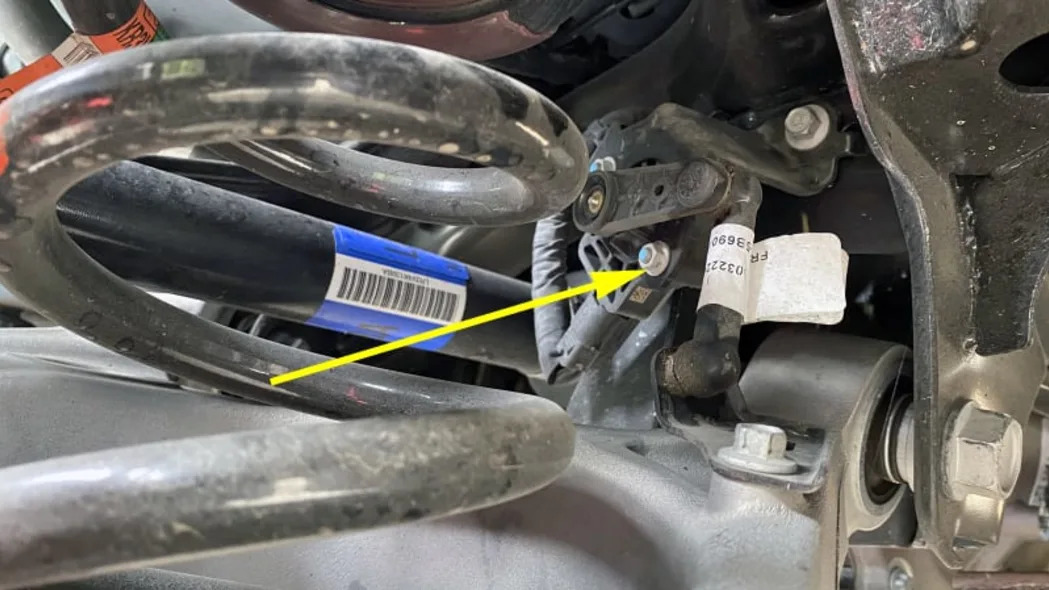
Like the front, the rear suspension has a height measurement sensor that feeds into the MR damper ECU.
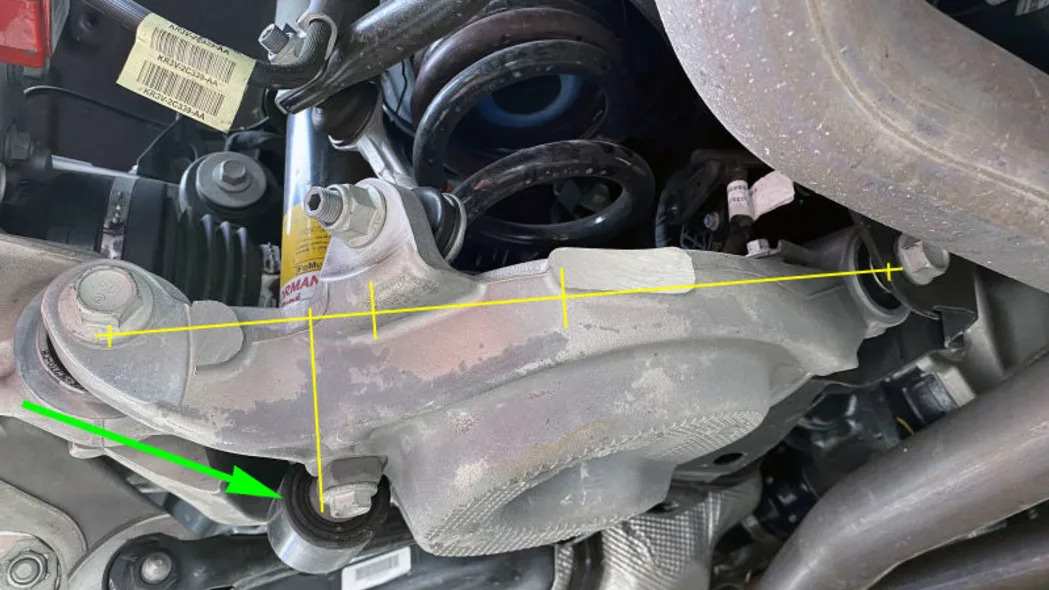
The image angle is less than ideal to make any concrete estimates, but you can at least see that our H-arm has even more work to do. It must shoulder every load associated with vertical suspension movement. Comparing its innermost pivot on the right to its ultimate attachment point on the left, the spring settles in about 45% of the way out, give or take. The stabilizer bar linkage is next in line at about 65% of the way out, followed by the shock absorber (green) at around 75% of the way out. These *very approximate* motion ratios represent how much less the various components will compress for a given amount of wheel travel.
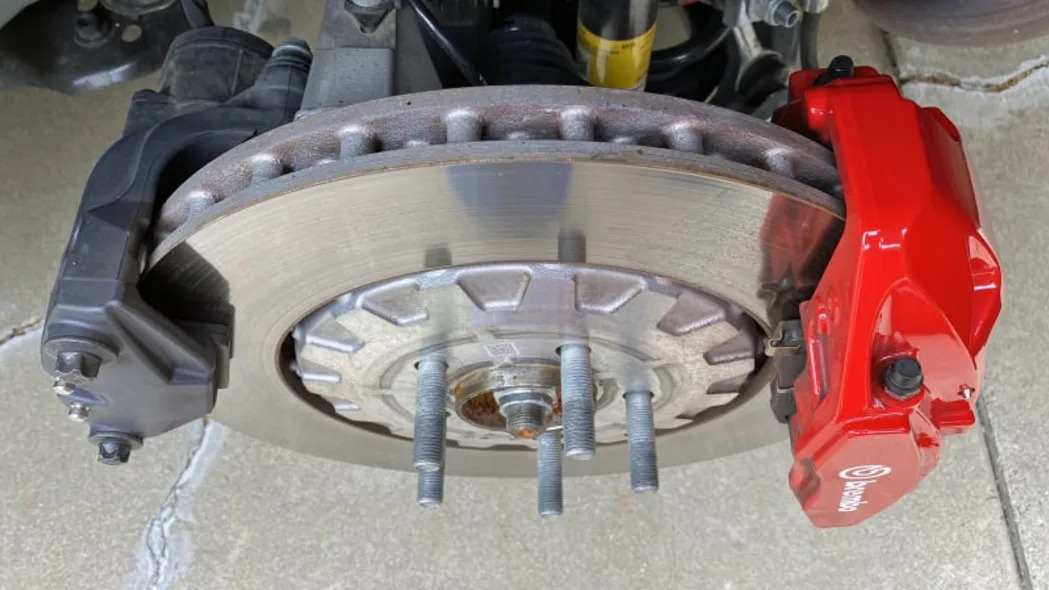
The GT500’s rear brake hub is uncommonly thin, and I’m going to guess that’s because the carbon fiber wheel hubs are so thick. The carbon fiber wheel’s design isn’t exactly deep-dish, so the extra thickness of the tricky wheels had to project inward. This wheel thickness business may be why the second caliper was needed in the first place because the GT350 has a normal-looking rotor hat with a drum parking brake built in. No room for that here.

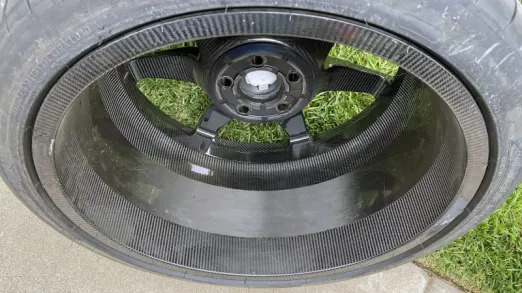
The rear wheel and tire assembly weighs 51 pounds, which is only a half-pound more than the fronts despite wider 315/30ZR20 tires and wider 11.5-inch rims. Why is the difference so small? At first I thought it might be the coating, but the Ford engineer I spoke with said that didn’t amount to much. He suggested that the front tires might be heavier than the rears because they’re built to steer the car and are subjected to higher cornering loads.
As for my 2015 Mustang GT comparison, its 275/40ZR19 tires and 9.5-inch wheels weighed 60.8 pounds back in the day. These much bigger shoes weigh almost 10 pounds less because they use carbon fiber.
You can see why the 2020 Ford Mustang Shelby GT500 impresses me far more than the 2013 example I drove cross country seven years ago. This car isn’t just a big honking engine enveloped by skunk stripes and Shelby badges. It still is that, but the GT500 is now ALSO a serious well-rounded track weapon that maximizes the full potential of the sixth generation Mustang’s long overdue shift to independent rear suspension.
Contributing writer Dan Edmunds is a veteran automotive engineer and journalist. He worked as a vehicle development engineer for Toyota and Hyundai with an emphasis on chassis tuning, and was the director of vehicle testing at Edmunds.com (no relation) for 14 years.
You can find all of his Suspension Deep Dives here on Autoblog.
Related Video:


Sign in to post
Please sign in to leave a comment.
Continue